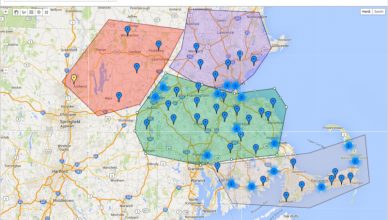A sales territory plan is crucial for tapping your potential customers, but field sales territory planning is easier said than done. So, you might be wondering how to build a sales territory plan that will ensure profitability by effectively targeting customers and reducing wastage of time.
Many factors often pose problems to territory management for all sales reps. For example, windshield time – AKA how long it takes for an employee to get from Point A to Point B during work hours – is a problem for all sales teams. Every minute your sales rep spends behind the wheel is a minute that could have been used to identify prospects, prepare presentations, and close sales.
Targeting the right customers is another important, yet challenging, task to achieve pre-set goals.
So, it stands to reason that you could increase productivity and make more money if you could somehow find a way to cut down on windshield time. What if your sales team spent less time driving around and more time making sales?
That would be the ideal scenario!
So, below we share sales territory planning best practices and a step-by-step guide to creating a territory sales plan and optimizing a sales process for long-term sales management. Read on.
#1 Identify And Segment Your Targets
The first step in designing a sales territory plan is to select the appropriate geographic control units that can be combined to form sales territories. These units should be homogeneous and of reasonable size to achieve economies of scale. You also need to decide on the allocation criteria for each territory and then conduct a workload analysis to reach a call size for each salesperson.
While doing so, remember that not all prospects are equal. Some are this close to becoming paying customers, while others are moonshots barely worth talking to.
The most efficient way to approach this situation is for your reps to target hot leads first, then work their way down to prospects who are less likely to sign on the dotted line. But it can be hard to keep track of which leads are hot and which are not. It’s a lot of information to process.
Sales territory mapping software like Route4Me makes processing information for sales reps a lot easier, though. It comes with a color-coding feature, which allows you to mark your leads, prospects, and customers by color.
You could use green for prospects that have a higher chance of leading to a sale and orange for prospects that will probably take more effort. Such segmentation of leads will ensure your sales reps are spending their time wisely.
RELATED: Why Every Sales Manager Needs A Sales Territory Mapping Software (and How Route4Me Can Help)
#2 Set Territory-Specific Goals
To get the most out of every territory, you should set territory-specific goals, including quotas and the objectives required to achieve them.
Past sales data will help you set manageable objectives.
Objectives might include selling a new product, penetrating a new market segment, or increasing account share by a certain percentage.
Want To See For Yourself How Route4Me Can Boost Your Profits?

Make a SWOT (Strengths, Weaknesses, Opportunities, Threats) analysis to establish tactics and strategies for a successful sales transaction. Then, create a more thorough action plan that details how to implement your strategy. Having a detailed plan in place will make it much easier to achieve your goals.
#3 No More Guesswork
Any old schmo can design a plan – but it takes true intelligence to design a plan that actually works.
If your plan is based on guesswork, then there’s a good chance that plan will fail.
This is why so many promising expansions end up being disasters. Business-owners see an untapped market that looks like a golden opportunity, so they invest in the extra infrastructure they need to take advantage of that opportunity. But when all is said and done, it turns out there isn’t that enough demand in the area to justify the expansion, so all the time and money that got poured into it was a complete waste.
To help prevent such disasters, you need to take the guesswork out of the equation and focus on hard facts.
Route4Me’s map routing software comes with an interactive map screen feature that shows you where your team is exceeding expectations and where they are lacking. This allows you to form a plan based on real-time data, showing you where you should focus your efforts or send your best people.
It can also show you exactly how much it would cost to expand into a given area beyond existing customers, so you’ll always know whether an expansion makes financial sense or not.
#4 Focus On Time Management
Effective sales territory planning is all about distribution.
The most efficient way to use your resources is to segment your sales team into different regions so that each sales rep makes a series of stops that are relatively close together. When clients are grouped closer together, your sales reps can visit more clients over a shorter period of time.
Route4Me’s sales mapping software has a territory management feature that enables you to draw a territory, name the territory, choose a color for its display on the map, save regions as groups, and plan routes based on region selection. You can add an unlimited number of territories by repeating this process. You can even draw overlapping territories and hide or display a specific territory on the map.
The best part is that route optimization software provides you with 100% optimized and accurate routes. You’ll never have to worry about your sales reps reaching customers on time again.
It’s easy to use, too: just upload the addresses that need to be visited, and your optimized route will be ready in less than 30 seconds, no matter how many stops you plug in.
#5 Reviewing Your Progress
No plan is perfect. You’re sure to come across some obstacles you didn’t anticipate when your ideas transition from your head to the real world.
To address these obstacles, you need to know that they exist in the first place. The only way to do that is to regularly review the progress of your plan.
You should utilize an analytics tool, such as route mapping software that comes with a reporting and analytics feature. Route4Me shows you total fuel expenses, how long it took sales reps to reach each customer location, how long sales reps stayed at each customer location, and many other useful tidbits of information, all from a single dashboard.
https://www.youtube.com/watch?v=DdMhoh-Sg6I&t=94s
Your data is displayed in a simplified format so that you can actually make sense of it. You can refer back to these reports on a quarterly, monthly, or even weekly basis to ensure your plan is on target.
So, do you have any questions on how to create a territory sales plan?
What strategies do you use to make your sales territory plan a success? Have you ever used routing optimization software? Let us know in the comments section below.
Want To See For Yourself How Route4Me Can Boost Your Profits?







